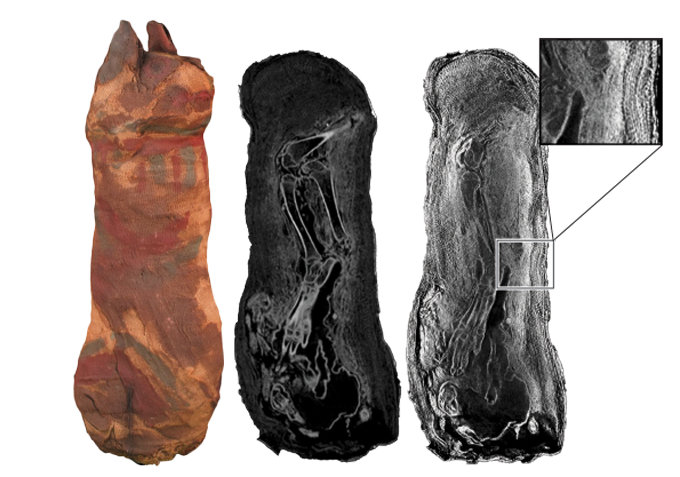Let’s learn about particles that help us peer inside objects
A zoo of particles can help image the insides of fossils, mummies, and more

X-rays and neutrons helped scientists peer inside this cat mummy from ancient Egypt without unwrapping it. The X-rays (center) revealed the cat’s skeleton. Neutrons (right) showed the details of its cloth wrappings.
C.A. Raymond and J.J. Bevitt/MATERIALS RESEARCH PROCEEDINGS 2020 (CC by 3.0)
Superman may have X-ray vision. But scientists have X-ray, neutron and muon vision. All these types of particles can be used to peer inside objects — from mummies to volcanoes to our own bodies.
X-rays might be the most familiar tools for seeing through things. X-rays are a type of light particle, or photon. When shined at an object, X-rays pass through some materials more easily than others. For instance, X-rays zip through soft tissue but get blocked by bone. That’s why bones stand out on medical X-ray images. It’s also why scientists can use X-rays to see mummies’ skeletons without unwrapping the bodies.
But X-ray imaging has its limits. These particles can’t pass through thick layers of metal, so objects encased in metal are invisible in X-ray images. Likewise, X-rays pass straight through soft things, so materials like fabric don’t show up in these pictures.
Fortunately, neutrons interact with materials very differently. These particles pass straight through lead, iron and other metals. This makes them useful for mapping the insides of cars and planes, as well as unveiling fossils coated in metal-rich mud.
What’s more, neutrons get blocked by hydrogen-rich stuff like water. So the watery insides of plants can stand out on neutron scans like bones do on X-rays. Neutrons have also revealed the details of delicate fabric layers swaddling mummies.
But what if scientists want to look inside something that’s too big to fit in an X-ray or neutron scanner? For that, they can use muons. These particles are heavy cousins of electrons. And they continually rain down on every part of Earth’s surface. Muons can pass through structures on the ground. But the denser the object, the fewer muons that make it all the way through. As a result, measuring how many muons pass through something, such as a volcano or a pyramid, can reveal hollow spaces inside.
Muons have not only helped map out magma chambers, but also exposed a secret chamber inside Egypt’s Great Pyramid of Giza.
Want to know more? We’ve got some stories to get you started:
Neutrons are unveiling hidden secrets of fossils and artifacts Images made with these particles have revealed details of dinosaur bones, mummies and more. (1/25/2024) Readability: 7.4
Muons reveal the inner worlds of pyramids, volcanoes and more Tracking these subatomic particles can uncover surprising hidden structures. (5/26/2022) Readability: 7.4
See what these animal mummies are keeping under wraps A new method of 3-D scanning reveals life and death details of a snake, a bird and a cat. (10/6/2020) Readability: 7.6
Explore more
New beetle species found in fossil poop of this dino relative
Scientists detect mystery void in Great Pyramid of Giza
Activities
Because X-rays pass through some materials more easily than others, certain parts of objects stand out on X-ray images while others are much fainter. Check out these 19 X-ray images of everyday objects. Can you guess what each one is without looking at the answer? (If you print out the pictures and show them to a friend, can they guess?) Which components of each object stand out in the image, and why do you think that is?
Plus: Want to learn more about what mummified flesh looks like under wraps — without needing a high-tech imager? Check out our experiment from Science Buddies.







